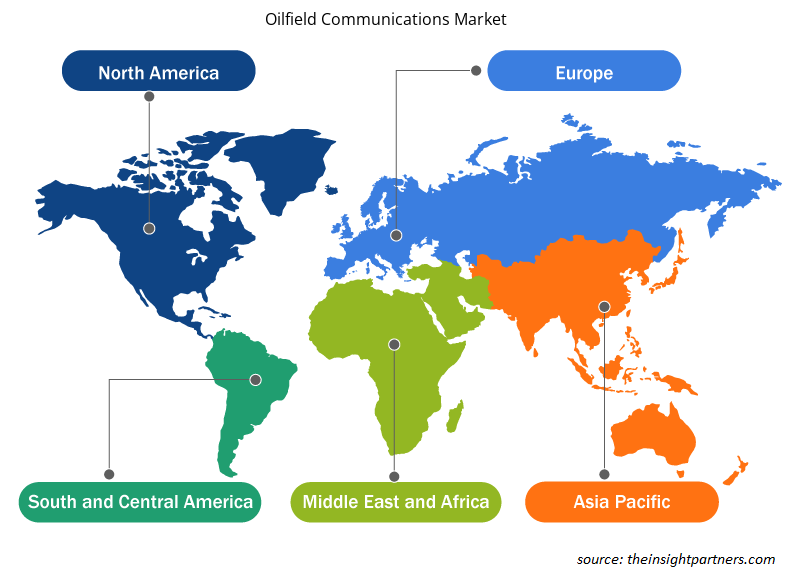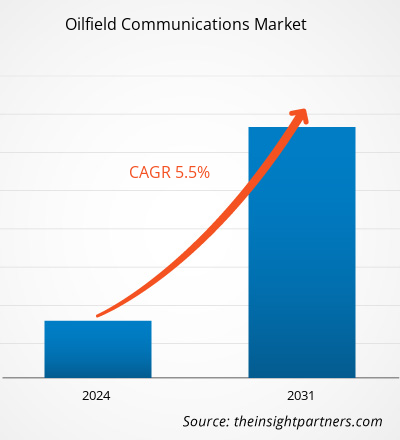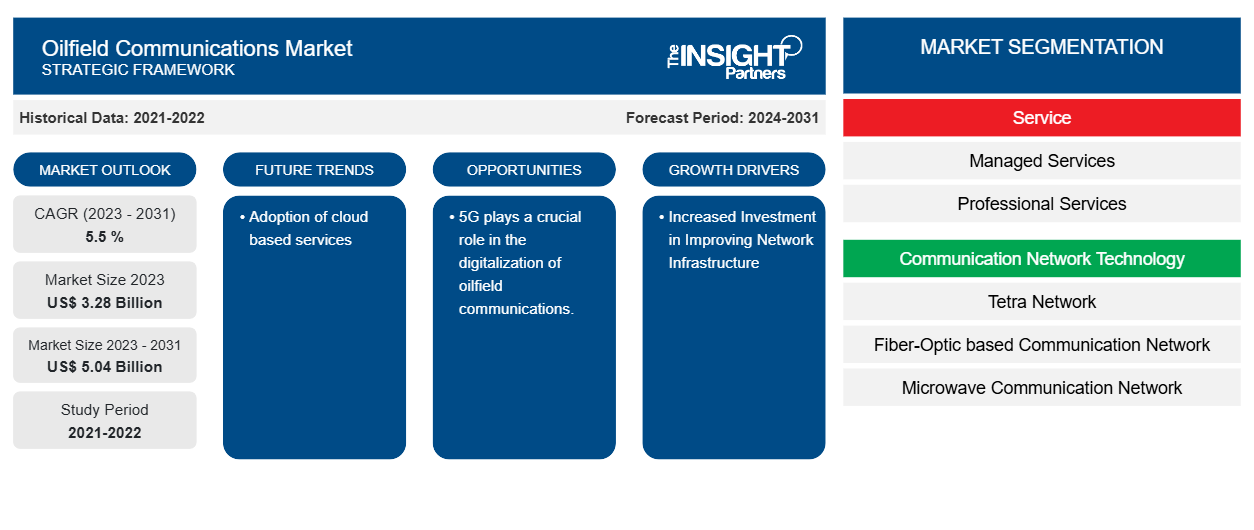Der Markt für Ölfeldkommunikation soll von 3,28 Milliarden US-Dollar im Jahr 2023 auf 5,04 Milliarden US-Dollar im Jahr 2031 anwachsen. Für den Markt wird für den Zeitraum 2023–2031 eine durchschnittliche jährliche Wachstumsrate von 5,5 % erwartet. Der Markt für Ölfeldkommunikation wächst aufgrund erhöhter Investitionen in die Netzwerkinfrastruktur, der gestiegenen Nachfrage von Öl- und Gasbetreibern nach Produktionsausweitung und Fortschritten in der Kommunikationstechnologie.
Ölfeldkommunikation Marktanalyse
Es wird erwartet, dass zunehmende technische Verbesserungen in der Ölfeldkommunikation das Marktwachstum in den kommenden Jahren vorantreiben werden. Darüber hinaus wird erwartet, dass eine steigende Nachfrage nach Kommunikationslösungen mit hoher Bandbreite sowie der Wunsch und die Bemühungen der Branche, Upstream-Anlagen zu verbessern, den Markt während des gesamten Prognosezeitraums antreiben werden. Die zunehmende Nachfrage nach Cloud-basierten Diensten, kombiniert mit einer wachsenden Betonung der Einführung effektiver Kommunikationstechnologie, wird die Nachfrage nach Ölfeldkommunikation verschärfen. Steigende Investitionen in die Netzwerkinfrastruktur sowie das Wachstum und die Expansion der Öl- und Gasindustrie werden dem Markt für Ölfeldkommunikation attraktivere Wachstumspotenziale eröffnen.
Marktübersicht für Ölfeldkommunikation
Ölfeldkommunikation bezieht sich auf Kommunikationssysteme, die mit dem Hauptziel implementiert werden, verschiedene Öl- und Gasunternehmen zu unterstützen oder zu betreuen, die möglicherweise Informationen für die Ölexploration, Produktionsprozesse, Berichtstechnologie, Automatisierung und andere Prozesse benötigen. Der Markt für Ölfeldkommunikation wird durch das exponentielle Wachstum und die breite Akzeptanz von Spitzentechnologien wie künstlicher Intelligenz, maschinellem Lernen , kognitiver Intelligenz und Cloud sowie durch erhöhte Investitionen in die Netzwerkinfrastruktur angetrieben, da für unternehmenskritische Aktivitäten auf den Ölfeldern, die auf konsistente Kommunikation angewiesen sind, zuverlässige Hardware erforderlich ist.
Passen Sie diesen Bericht Ihren Anforderungen an
Sie erhalten kostenlos individuelle Anpassungen an jedem Bericht, einschließlich Teilen dieses Berichts oder einer Analyse auf Länderebene, eines Excel-Datenpakets sowie tolle Angebote und Rabatte für Start-ups und Universitäten.
-
Holen Sie sich die wichtigsten Markttrends aus diesem Bericht.Dieses KOSTENLOSE Beispiel umfasst eine Datenanalyse von Markttrends bis hin zu Schätzungen und Prognosen.
Treiber und Chancen auf dem Ölfeldkommunikationsmarkt
Erhöhte Investitionen in die Verbesserung der Netzwerkinfrastruktur zur Förderung des Marktes
Die Öl- und Gasindustrie nutzt seit Jahrzehnten ihre eigenen Telekommunikationsnetze. Diese privat geführten und verwalteten Netze überwachen den täglichen Betrieb und koordinieren im Krisenfall die Notdienste. Moderne unternehmenskritische Netze stehen vor zwei Herausforderungen. Erstens besteht Modernisierungsbedarf. Echtzeitdaten, anspruchsvolle Steuerung und Überwachung sowie hohe Sicherheit erfordern eine Infrastruktur, die über die Fähigkeiten von Schmalbandnetzen hinausgeht. Zweitens muss eine qualitativ hochwertige Kommunikation sichergestellt werden. Für die Kommunikation in Öl- und Gasfeldern sind drahtlose Netzwerke mit hoher Kapazität erforderlich, die auch in rauen Umgebungen funktionieren.
5G spielt bei der Digitalisierung der Ölfeldkommunikation eine entscheidende Rolle.
Die Öl- und Gasindustrie kann von privaten Long-Term Evolution (LTE)- und 5G-Netzen profitieren, da die 4G-Funktechnologie schnell angenommen wird und sich 5G-Standards für industrielle Anwendungsfälle entwickeln. Die Ambitionen der Öl- und Gasindustrie hinsichtlich der Einführung von 5G bleiben ungewiss. Es wird erwartet, dass die 5G-Technologie Öl- und Gasunternehmen in Zukunft einen erheblichen Wettbewerbsvorteil verschaffen wird. Öl-E&P-Unternehmen legen Wert auf Effizienz und Agilität, was zu ehrgeizigen digitalen Anstrengungen führt. 5G bietet Vorteile in der Öl- und Gasindustrie, darunter Ultra-Reliable Latency Communication (URLLC) und Machine Type Communication (MMTC).
Segmentierungsanalyse des Marktberichts zur Ölfeldkommunikation
Wichtige Segmente, die zur Ableitung der Marktanalyse für Ölfeldkommunikation beigetragen haben, sind Service, Kommunikationsnetzwerktechnologie, Feldstandort und Lösung.
- Basierend auf dem Service ist der Markt für Ölfeldkommunikation in Managed Services und Professional Services segmentiert.
- Basierend auf der Kommunikationsnetzwerktechnologie ist der Markt für Ölfeldkommunikation in Tetra-Netzwerke, glasfaserbasierte Kommunikationsnetzwerke, Mikrowellen-Kommunikationsnetzwerke, Mobilfunk-Kommunikationsnetzwerke und VSAT-Kommunikationsnetzwerke segmentiert.
- Basierend auf der Feldlage ist der Markt für Ölfeldkommunikation in Onshore-Kommunikation und Offshore-Kommunikation segmentiert.
- In Bezug auf die Lösungen ist der Markt in Midstream-Kommunikationslösungen, Downstream-Kommunikationslösungen und Upstream-Kommunikationslösungen segmentiert.
Ölfeldkommunikation Marktanteilsanalyse nach Geografie
Der geografische Umfang des Berichts zum Ölfeldkommunikationsmarkt ist hauptsächlich in fünf Regionen unterteilt: Nordamerika, Asien-Pazifik, Europa, Naher Osten und Afrika sowie Südamerika/Süd- und Mittelamerika. Nordamerikanische Firmen suchen nach hochmodernen digitalen Kommunikationslösungen für ihre Onshore- und Offshore-Felder. Viele Öl produzierende Unternehmen haben ihren Hauptsitz in den USA. Die meisten Unternehmen testen neue Dienste in ihrem eigenen Land, bevor sie sie international einführen. Die schnelle Einführung neuer Technologien in diesem Land sowie die zunehmende Betonung weltweiter Kommunikation treiben den Markt voran.
Regionale Einblicke in den Ölfeldkommunikationsmarkt
Die regionalen Trends und Faktoren, die den Ölfeldkommunikationsmarkt während des Prognosezeitraums beeinflussen, wurden von den Analysten von Insight Partners ausführlich erläutert. In diesem Abschnitt werden auch die Marktsegmente und die Geografie des Ölfeldkommunikationsmarkts in Nordamerika, Europa, im asiatisch-pazifischen Raum, im Nahen Osten und Afrika sowie in Süd- und Mittelamerika erörtert.

- Erhalten Sie regionale Daten zum Ölfeldkommunikationsmarkt
Umfang des Marktberichts zur Ölfeldkommunikation
| Berichtsattribut | Details |
|---|---|
| Marktgröße im Jahr 2023 | 3,28 Milliarden US-Dollar |
| Marktgröße bis 2031 | 5,04 Milliarden US-Dollar |
| Globale CAGR (2023 - 2031) | 5,5 % |
| Historische Daten | 2021-2022 |
| Prognosezeitraum | 2024–2031 |
| Abgedeckte Segmente |
Nach Service
|
| Abgedeckte Regionen und Länder |
Nordamerika
|
| Marktführer und wichtige Unternehmensprofile |
|
Dichte der Marktteilnehmer für Ölfeldkommunikation: Die Auswirkungen auf die Geschäftsdynamik verstehen
Der Markt für Ölfeldkommunikation wächst rasant, angetrieben durch die steigende Nachfrage der Endnutzer aufgrund von Faktoren wie sich entwickelnden Verbraucherpräferenzen, technologischen Fortschritten und einem größeren Bewusstsein für die Vorteile des Produkts. Mit steigender Nachfrage erweitern Unternehmen ihr Angebot, entwickeln Innovationen, um die Bedürfnisse der Verbraucher zu erfüllen, und nutzen neue Trends, was das Marktwachstum weiter ankurbelt.
Die Marktteilnehmerdichte bezieht sich auf die Verteilung von Firmen oder Unternehmen, die in einem bestimmten Markt oder einer bestimmten Branche tätig sind. Sie gibt an, wie viele Wettbewerber (Marktteilnehmer) in einem bestimmten Marktraum im Verhältnis zu seiner Größe oder seinem gesamten Marktwert präsent sind.
Die wichtigsten auf dem Markt für Ölfeldkommunikation tätigen Unternehmen sind:
- ABB Ltd
- Airspan Networks Inc.
- Baker Huges Incorporated
- Ceragon Networks Ltd.
- Commscope Holding Company, Inc.
- Commtel Networks Pvt. GmbH.
Haftungsausschluss : Die oben aufgeführten Unternehmen sind nicht in einer bestimmten Reihenfolge aufgeführt.

- Überblick über die wichtigsten Akteure auf dem Ölfeldkommunikationsmarkt
Nachrichten und aktuelle Entwicklungen zum Ölfeldkommunikationsmarkt
Der Markt für Ölfeldkommunikation wird durch die Erhebung qualitativer und quantitativer Daten nach Primär- und Sekundärforschung bewertet, die wichtige Unternehmensveröffentlichungen, Verbandsdaten und Datenbanken umfasst. Im Folgenden finden Sie eine Liste der Entwicklungen auf dem Markt:
- Im Mai 2022 haben Ericsson und Tampnet zusammengearbeitet, um IoT-Verbindungen für Offshore-Unternehmen zu verwalten. Moderne Sensoren und Fernüberwachungstechnologien können in einer Vielzahl von Offshore-Anwendungsfällen an Personen und Objekten installiert und dank der Verwaltungsfunktionen des Ericsson IoT Accelerator in Echtzeit verbunden werden.
(Quelle: Ericsson, Unternehmenswebsite, 2022)
- Im Dezember 2022 arbeiteten DeepOcean und Akvaplan-Niva zusammen, um die Umweltauswirkungen der Offshore-Wind-, Öl- und Gasförderung mithilfe ferngesteuerter Fahrzeuge (ROVs) und unbemannter Gleitfahrzeuge (USVs) zu bewerten.
(Quelle: DeepOcean, Unternehmenswebsite, 2023)
Marktbericht zur Ölfeldkommunikation – Umfang und Ergebnisse
Der Bericht „Marktgröße und Prognose für Ölfeldkommunikation (2021–2031)“ bietet eine detaillierte Analyse des Marktes, die die folgenden Bereiche abdeckt:
- Marktgröße und Prognose auf globaler, regionaler und Länderebene für alle wichtigen Marktsegmente, die im Rahmen des Projekts abgedeckt sind
- Marktdynamik wie Treiber, Beschränkungen und wichtige Chancen
- Wichtige Zukunftstrends
- Detaillierte PEST/Porters Five Forces- und SWOT-Analyse
- Globale und regionale Marktanalyse mit wichtigen Markttrends, wichtigen Akteuren, Vorschriften und aktuellen Marktentwicklungen
- Branchenlandschaft und Wettbewerbsanalyse, einschließlich Marktkonzentration, Heatmap-Analyse, prominenten Akteuren und aktuellen Entwicklungen
- Detaillierte Firmenprofile
- Historische Analyse (2 Jahre), Basisjahr, Prognose (7 Jahre) mit CAGR
- PEST- und SWOT-Analyse
- Marktgröße Wert/Volumen – Global, Regional, Land
- Branchen- und Wettbewerbslandschaft
- Excel-Datensatz
Aktuelle Berichte
Erfahrungsberichte
Grund zum Kauf
- Fundierte Entscheidungsfindung
- Marktdynamik verstehen
- Wettbewerbsanalyse
- Kundeneinblicke
- Marktprognosen
- Risikominimierung
- Strategische Planung
- Investitionsbegründung
- Identifizierung neuer Märkte
- Verbesserung von Marketingstrategien
- Steigerung der Betriebseffizienz
- Anpassung an regulatorische Trends























 Kostenlose Probe anfordern für - Markt für Ölfeldkommunikation
Kostenlose Probe anfordern für - Markt für Ölfeldkommunikation